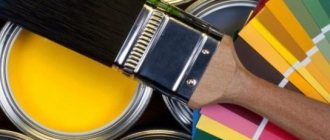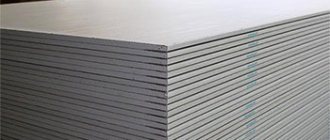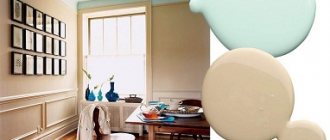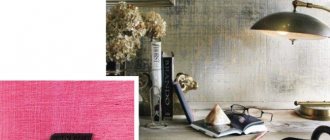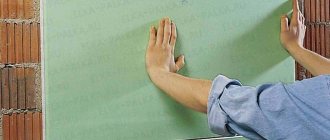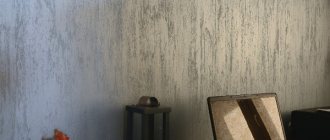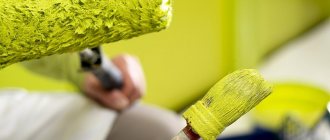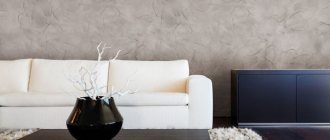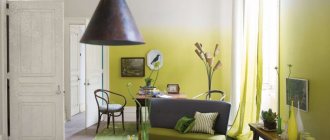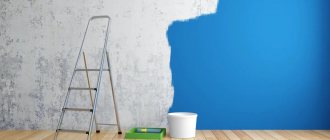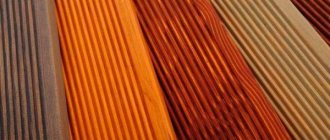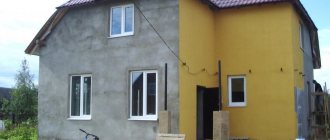Finishing materials are constantly changing. Wallpaper has been replaced by paint for the walls in the apartment in its variety of colors offered and with different characteristics. For the interior, they choose environmentally friendly, without a strong odor and allowing the walls to breathe. Waterproof, easy to clean coating in the kitchen and wet areas. In the hallway and corridor it is appropriate to protect the walls with an anti-vandal compound.
Advantages, characteristics and types
Painting walls allows you to create a unique interior in which the owner embodies his tastes and concepts of comfort. A room on the north side can become warm and sunny, thanks to hot tones, a small one will be visually enlarged. Paint for walls in an apartment, how to choose the right one for the kitchen with its steam and the children's room, where people who like to paint on all surfaces live.
The material for coloring has its positive aspects:
- huge color palette;
- easy to combine;
- the ability to decorate in various ways;
- quick and easy application method;
- does not tempt animals to peel and scratch to the same extent as wallpaper;
- durable surface;
- convenient to cover complex surfaces, niches, arches;
- allows you to quickly change the style of the room.
The disadvantages include preparing the surface for painting; puttying and cleaning require special skills, time and expense.
The choice of paint for walls in an apartment should take into account its characteristics:
- Covering power - how many layers need to be applied to obtain an even color.
- Drying and polymerization time.
- Vapor permeability is the ability of walls to breathe after painting.
- Thixotropy is the ability of paint to change thickness during application. Good quality for beginners, practically no drips are formed.
- Environmentally friendly - the composition does not emit harmful substances.
- Moisture resistance – washable.
- Smell.
- Application method: brush, roller, spray.
Manufacturers offer a large selection of different finishing materials. Popular types of interior paints have a base:
- oil;
- silicate;
- alkyd;
- nitrocellulose;
- water
Quick-drying paint - NC (nitrocellulose), used in Khrushchev-era buildings for painting floors and panels, has now been abandoned. It dries quickly, allowing you to do cosmetic repairs in a weekend. But its smell can poison apartment residents and neighbors for several more days. By repelling water, the surface quickly loses its shine and wears off, requiring constant renewal. A durable film of hardened nitrocellulose prevents the walls from breathing and promotes the appearance of fungus.
What paint is better to paint the walls in an apartment to create comfort and a healthy living climate? In each case, it is necessary to select individually.
Selecting paint for specific materials
The optimal options for each base are different. Therefore, when choosing a material, it is extremely important to take this correspondence into account.
- Concrete. For such walls, you can choose either acrylic or latex paint. Silicate materials are also suitable.
- Tree. There are also two contenders here - oil and latex composition. The favorite is an odorless and “breathable” water-based material.
- Plaster. In this case, the leaders are those with low vapor permeability. To transform decorative plaster, latex paint is the best option. Other potential candidates are silicate, acrylic and silicone.
Both water-based and water-dispersion paints are suitable for finishing plasterboard walls. The latter are any: acrylic, latex or silicone materials. You can use other paints - oil, alkyd. There is one exception for drywall: these are compositions containing lime.
Oil formulations
When oil paint is applied, it dries to form a durable, glossy film that does not allow air to pass through. The surface is not afraid of water. It can be washed with mild products and wiped dry. Otherwise there will be divorces. An oil-based coating quickly loses its gloss, and after 3 years it begins to crack and peel. Wipes off the floor and protruding corners.
When repainting without changing the color, it is enough to apply 1 layer. When changing from a dark color to a light, contrasting tone, up to 3 layers of coating are needed. When switching to other types of paint, the coating is removed down to the base. MA compositions are not compatible with other finishing materials.
All types of oil paints have one advantage - low cost. Their popularity is in the past. Other materials came to replace it.
Paint based on PVA glue
Pros:
— PVA-based paint is gentle on walls: they “breathe,” which means that their top layer will not deteriorate over time, as is the case with oil-based paint;
— paint fumes are completely non-toxic, and this has a good effect on the ecology of the house.
Minuses:
- this is the most short-lived and capricious type of water-based paint;
- dirt cannot be washed off from it, so it is used only for the ceiling and exclusively in dry rooms;
Alkyd paints
When deciding what paint to paint the walls in the kitchen, you should consider alkyd compounds. They differ from oil paint because they have a natural base. Vegetable oils are treated with acids. The pigments, binders and consistency remain the same as in oil paints. When applied to the wall, white spirit and turpentine are used as a solvent, which quickly evaporate, but require the use of a respirator during work.
Alkyd compositions have a large selection of colors, are resistant to moisture and partially allow the walls to breathe. They are flexible and durable and wash well. They can be used in the kitchen and utility rooms. It is not recommended to use in bedrooms and children's rooms.
What paint is best to paint walls?
There is no clear answer to this question. It all depends on the specific room, humidity conditions, lighting, surface properties and the surrounding interior.
An important factor is the money issue. Good paint for interior work is no less expensive than high-quality wallpaper. The result of the repair will definitely be completely new. And the ease of implementation for an inexperienced person is a relative matter. For an impeccable result, it is better to use the designer’s advice. Plain walls may need to be decorated with paintings, shelves, and vases.
But, if you work hard, painting the walls can literally “transform” your apartment into a completely new home!
Silicate durable coatings
Silicate compositions are based on liquid glass. They are used mainly outside and protect the facade from rain and weathering. In an apartment, they can be used in well-ventilated wet areas of bathrooms, kitchens, and boiler rooms. The strength and resistance to abrasion of silicate paint make it possible to preserve the walls in the hallway intact for a long time, where they are constantly exposed to impacts from bags and other objects.
The main advantage of silicate compounds is that fungus and mold do not form on them, and those that were already in the plaster layer die.
The disadvantage of silicate dyes is their low vapor permeability coefficient and limited color palette. The composition contains many alkalis that negatively affect the respiratory system. When painting, you must wear a respirator and do not enter the room until polymerization is complete. After drying, the silicate composition is harmless.
Paints for upgrading kitchens, baths and hallways
Such premises require the use of more durable paints that resist both moisture and mechanical stress. Acrylic and silicone decorative paints are considered the most suitable. If you use relief paints, then such surfaces will be difficult to keep clean, since such a surface collects dust and dirt. The presence of mother-of-pearl stains allows you to visually enlarge small rooms, as if making them more spacious.
There are types of paints that are more suitable for decorating such spaces, with the exception of living rooms.
Alkyd paints
This type of paint is more reminiscent of oil paint in its consistency, but differs in base and performance characteristics. Surfaces painted with alkyd paints perfectly withstand humid environments, elevated temperatures, and exposure to sunlight. In addition, they have vapor permeability, although not high, so such paints are ideal for painting wet rooms. Alkyd paints can be used to paint both wooden and metal surfaces. These paints are not expensive, so coating surfaces will not require additional investment, especially since working with such paints is quite simple. The only thing that is required is the preparation of the surfaces, otherwise a normal decorative look will not work. Such paints are produced to obtain glossy, semi-matte and matte surfaces.
Examples of alkyd paints
Such paints have one significant drawback, which is that they are diluted with organic solvents such as white spirit, gasoline and turpentine. In this regard, you should take into account the fact that after painting there is a peculiar smell in the room. To get rid of it, it is enough to ventilate the room well. The disadvantage of such paints is their loss of decorative properties over time: they lose color brightness, acquiring a yellowish tint, which indicates the fragility of the coating, although this is not an expensive option. Radiators and heating system pipes are painted with these paints. For such purposes, more heat-resistant compositions are produced, as well as special compositions for painting walls.
Paints based on silicates (liquid glass)
The coating formed as a result of painting the surface with such paints has unique characteristics that prevent the appearance of fungus and mold. If there is a similar problem in the room, then using this paint will help solve this problem. In addition, the result is a durable and strong coating, with the highest vapor permeability, which many paint and varnish coatings have. Such paints are most suitable for rooms with high humidity.
Silicate paint - prevents the development of fungi and mold
Despite their advantages, these paints have a number of disadvantages. The first drawback is that it is harmful to human health, so working with such paints without protective equipment is not recommended. After drying, you should also not stay in the room until the complete crystallization process has passed. Another and also significant drawback is incompatibility with other types of coatings, therefore it will not be possible to cover surfaces previously painted with other paints with them, as well as otherwise, when another paint will not “lay” on a surface painted with silicate paint. Therefore, in both cases, you will have to remove the previous layer of paint, and this is not always possible, especially complete removal. Among other things, to obtain different colors you will have to use mineral dyes, which affects the number of colors.
Graphite coating in a children's room
Graphite wall paint has the main qualities that distinguish it from other materials:
- high abrasion resistance;
- heat resistance.
The graphite included in the composition creates a rough surface on which chalk and felt-tip pens can draw well. The inscriptions can be easily removed with a damp sponge. The graphite mixture is harmless and can be used to paint walls in nurseries, create durable low panels in corridors and other places where the wall is constantly exposed to friction.
The second quality and good adhesion to metal and stone expand the use of graphite paint in places with high temperatures. It is used to paint stone and iron fireplaces, chimneys, and stoves. In addition to classic black, other colors of graphite mixtures for interiors are available.
Wall painting options
You can paint walls in a residential or non-residential area in different ways, since there are no restrictions in this matter. It is very important to choose the right combination of colors, and here you cannot do without a special table that designers use, otherwise it is unlikely that you will be able to choose colors that would combine with each other.
This approach is especially relevant if combined painting of walls is planned, using several colors and their shades.
Dividing the surface horizontally into zones
Painting a room in two colors: horizontal division
As a rule, the surface is divided horizontally into two zones, with the lower zone being painted in darker colors, and the upper zone in lighter colors. There is also a horizontal division into 3 zones, while smooth transitions from below from darker shades to lighter ones are always practiced. In fact, this is a classic approach, but in reality you can find the reverse distribution of colors and the area under the ceiling is painted in a dark color. Despite the originality of the approach, this technique visually lowers the ceiling, which does not always look harmonious. This is especially true in relation to rooms where the ceilings are low and it is better to make them visually higher.
The molding can be left white - it goes with any colors, or it can be painted in one of the suitable colors
On the border of two colors it is difficult to make a perfectly even distinction, even if professionals work. As a rule, this place is decorated with moldings or other elements. Alternatively, you can use masking tape, which should be glued evenly, but even this technique does not provide any guarantee of obtaining an even line. The presence of molding makes the interior more attractive and richer, while the presence of a straight line indicates minimalism more.
Zone allocation
Recently, it has become fashionable to highlight areas in a room by painting them in different colors. In this case, you can use two options:
- Paint the selected area with a darker shade of the same color.
- Use other colors that go together.
If you select colors correctly, then regardless of the chosen option, the room will look very unique and attractive. By applying this or that method in practice, it is possible to obtain a memorable and bright interior of the room.
A bright color from the same palette is the easiest way to brighten up your interior.
The decoration of any room should be approached individually, taking into account the purpose of the room. If we take into account the bedrooms, then softer color combinations should be used here. More contrasting combinations are more suitable for living rooms and children's rooms. As a rule, children like bright color combinations.
Presence of a horizontal stripe
A wide horizontal stripe is another way to paint a room in two colors.
This refers to a wide stripe that is placed horizontally on the surface, at eye level. This technique is preferable to use if you plan to highlight a number of decorative elements located on the wall. These could be paintings, a series of shelves, built-in niches or cabinets, etc.: there can be many options.
This type of wall design may be suitable for arranging walls in corridors when it is necessary to visually lower the ceiling. Children's rooms also look good when such a stripe highlights children's drawings on the walls.
Wall decoration in the form of stripes
Striped walls are another example of decor, although this technique should not be used when the question arises of decorating all the walls. As an option, it is permissible to make one of the walls or part of it striped to focus attention.
You can achieve an interesting effect if you use stripes of the same shade, but of different textures. Although they have one shade, they look like several colors.
Highlighting interior elements
Highlighting some elements is another way to combine painting a room.
If it is necessary to highlight one or more interior elements, it is painted with a different color, more contrasting, or less contrasting, depending on individual preferences. Such elements can be niches, shelves, various frames, as well as other decorative elements.
The first option is a stripe, more contrasting than the main shades, which runs along the contour of the wall at its corners. This approach allows you to visually expand the room if it is small.
Group of water-soluble compounds
Water-soluble paints are separated into a separate large group. They have different bases and binders. All formulations are soluble in water, do not contain harmful substances and are completely safe. If there are no material restrictions, then the question of what paint to paint the walls in the apartment should be decided in favor of water-soluble compounds. The choice of types is large:
- water-dispersed acrylic;
- silicone;
- latex;
- butadiene-styrene;
- water-based.
Water-soluble compositions have medium and high vapor permeability and allow the walls to breathe. After polymerization, their surface does not absorb water and many types of compositions can be washed.
Acrylic water-dispersion compositions
The most popular types of paints for walls in an apartment. They have a high cost, which is compensated by the positive characteristics of the material:
- easy to apply;
- good hiding power;
- does not fade;
- tightens cracks up to 1 mm;
- unlimited color palette;
- durable coating;
- washable;
- average vapor permeability.
In branded stores you can choose any shade you like from a card. It will be created using a tinting machine in a few minutes, and the buyer will receive the paint of the desired tone. For each color, the number of shades is in the dozens.
Silicone water dispersion
The ideal washable paint for kitchen walls is silicone water-dispersion. After drying, the wall can be washed any number of times with any substances except those containing abrasives. The surface is perfectly flat. Cracks up to 2 mm wide are healed. Good vapor permeability allows the walls to breathe and remove moisture out. Fungus and mold appear rarely. Does not fade in the sun. Resistant to abrasion.
Coverage is good, but working with silicone compounds requires skill. The cost is high. The decorative appearance lasts up to 10 years.
Latex water soluble materials
Latex paints for apartment walls are washable and are used mainly in the kitchen and hallway. Vapor permeability is good. The material is easy to apply and heals small cracks. When coated in 2 layers, a smooth and durable surface film is formed. The cost is average. Large selection of colors.
Disadvantages include sunburn and the difficulty of washing dried composition off the skin of your hands and metal tools.
Styrene-butadiene dyes are analogous to latex dyes, with a synthetic base component. Styrene butadiene is a type of artificial rubber. Low cost and high adhesion allow them to be used as a primer and base for light water-soluble compositions.
Compositions based on polyvinyl acetate
Water-based paint was the first water-soluble paint to appear in stores. Its base is polyvinyl acetate, better known as PVA. Advantages of the material:
- easy to apply;
- washes off hands and tools with water;
- compatible with all water-soluble compounds;
- tinted in any color;
- dries quickly;
- has no smell;
- low cost.
Water emulsion has more disadvantages than expensive analogues:
- turns yellow quickly;
- afraid of water;
- poor abrasion resistance;
- cannot be washed.
I need paint for drywall, which one to choose. Water-based one works well. It allows moisture to pass through itself, which the gypsum absorbs and releases back if the air is dry. Under it, you can use PVA glue diluted with water as a primer.
Water-based paint is an odorless, quick-drying, environmentally friendly wall paint. It can be used to paint walls in bedrooms and living rooms.
Selection of combination: paint - room
What paint is best for walls? It is clear that for painting rooms they choose compositions intended only for interior work. However, rooms with different conditions and purposes require choosing the optimal option for each room.
Corridors, hallways
“Rogue” premises do not belong to “safe” premises. It is important for them to choose a finishing coating that will be easy to clean from any contaminants. The preferred option is a latex composition. It is better to select products in the mid-price category: they are a guarantee of quality. By chasing cheapness, you can get results that will soon disappoint.
Bathrooms and kitchens
The first threats are temperature changes and high humidity. Secondly, soot and drops (of broth and fat) are added to them, flying during cooking and onto the walls. Therefore, such extreme conditions require paint that must be waterproof, but vapor permeable, chemically inert, and easily washable. Two candidates meet these requirements: latex and silicone. The latest finishing materials can also be used to decorate wall panels.
Children's
These rooms are often decorated by future “artists”, so the paint simply must “wash off” easily and without problems. Therefore, when choosing, you need to look towards those acrylic compounds that will withstand such cleansing. Environmental friendliness and hypoallergenicity are important for little owners, so the best option is high-quality ECO paints designed specifically for decorating children's rooms.
Living rooms and bedrooms
For these rooms, acrylic, matte or deep-matte paints will be optimal. The main thing is that the only requirement for them here is high vapor transmission capacity. These compounds do not need maximum strength or protection from moisture. Therefore, it makes little sense to consider more expensive latex or silicone products for their design.
Unique anti-vandal coating
Currently, German manufacturers have produced anti-vandal paint for walls. The transparent coating is applied to the painted and any other surface in 2 layers. After drying, the felt-tip pen and spray paint are easily washed off the wall. Even glue does not stick to a surface with zero adhesion.
The composition is intended mainly for facades. Can be applied to poles and fences. If there are a lot of painters in the apartment, anti-vandal coating will be useful to preserve the walls and nerves.
Do-it-yourself painting of walls in an apartment
First of all, you should decide on the type of paint, and secondly, you need to know how to work with it correctly, although this is always written on the packaging. Each type of paint is characterized by its own unique properties. Despite this, the technological steps have some common characteristics. These include:
- Preparation of surfaces with removal of old coating. The quality of this stage depends on the compatibility of the old and new coating. In case of incompatibility, you will have to very carefully remove the old coating so that not the slightest hint of its presence remains.
- Puttying a surface using a specific type of putty that is applied with a spatula. The task of this stage is to seal all the cracks and get rid of irregularities.
- Surface grinding is carried out after the putty layer has completely dried. To grind surfaces, sandpaper or a special metal mesh is used, which are attached to a wooden block or a special grater. Using circular movements, get rid of unevenness.
- Removing dust from the surface after sanding. You can simply get by with a dry cloth or use a vacuum cleaner, which is more practical and effective.
- Applying a primer, which ensures more reliable adhesion of the paint to the surface. It is advisable to use primer from the same company as the paint.
- The process of painting surfaces. As a rule, at least 2 layers are applied. Each subsequent layer is applied perpendicular to the direction of application of the previous layer and only after complete drying. In any case, you should strictly follow the instructions.
After this, you can safely say that the surface is painted, be it walls or ceiling.
How to paint a wall
Popular manufacturers
The list of manufacturers of wall materials is large. Each company has its regular customers. Tikkurila wall paint is in demand due to its optimal price-quality ratio. The company produces all types of materials, from dry mixtures to paint and varnish products. It's easy to select finishes and cladding on one base.
Good quality is noted by experts from the companies Knauf, Starateli, Ceresit and other companies. Every person, starting a renovation, will be able to find exactly the wall paint that he likes, which will convey his character and mood.
Choosing the best interior washable paint
All washable paints that are used for cladding surfaces in residential environments are standard white. To obtain any shade, building pigments are added independently. Depending on the intensity of color required, the amount of pigment changes: the more composition is added, the brighter the coating will be. Learn a few tips that will help you decide on the type of paint structure for each individual case.
- Deep matte. This is a high-quality coating that does not reflect incoming light. Suitable for large spaces. Copes with construction irregularities, errors in putty and other repair defects.
- Matte. Attracts a significant amount of light, both natural and artificial. However, there is a slight degree of gloss, which can reflect some large errors. Able to hide only minor imperfections.
- Semi-matte or semi-gloss. Both of these options are ideal for small rooms. The dried coating tends to reflect objects, as well as light falling on the walls.
Important! Experts prove that deep matte paint adheres better to walls, provided that the adhesive composition has been correctly applied previously.
Creating a design using washable wall paint Source roomester.ru
